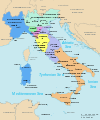Savoyard state
This article needs additional citations for verification. (April 2017) |
Savoyard state | |||||||||
|---|---|---|---|---|---|---|---|---|---|
| 1003–1861 | |||||||||
| Motto: FERT | |||||||||
 The Savoyard state in 1839 | |||||||||
| Status | Former plurinational independent state Former constituent territories of the Holy Roman Empire | ||||||||
| Capital | Montmélian (1006–1295) Chambéry (1295–1562) Turin (1562–1792)-(1815–1821) Cagliari (1792–1815) | ||||||||
| Common languages | French, Italian, Piedmontese, Arpitan, Occitan, Latin | ||||||||
| Religion | Roman Catholicism | ||||||||
| Government | County, Duchy and Kingdom | ||||||||
| Count Duke King | |||||||||
• 1003–1048 | Humbert I White Hands (first) | ||||||||
• 1849–1861 | Victor Emmanuel II of Sardinia (last) | ||||||||
| Historical era | Medieval era Modern era | ||||||||
• Humbert I became Count of Savoy | 1003 | ||||||||
• Kingdom of Sardinia became Kingdom of Italy | 1861 | ||||||||
| |||||||||
The Savoyard state is a term of art used by historians to denote collectively all of the states ruled by the counts and dukes of Savoy from the Middle Ages to the formation of the Kingdom of Italy. At the end of the 17th century, its population was about 1.4 million.[1][2]
History
The multi-century history of Savoy included the period before the County of Savoy, then the County of Savoy, the Duchy of Savoy, the period from Savoy to Sicily and Sardinia before Italian unification, and thereafter.
From the Middle Ages, the state comprised the Duchy of Savoy, the Principality of Piedmont, the Duchy of Aosta and the County of Nice, all of which were formally part of the Holy Roman Empire. However, the Savoyards often acted against the Emperor, repeatedly siding with the French during the Franco-Habsburg Wars. From 1708, it included the Duchy of Montferrat, then the Kingdom of Sicily from 1713 until 1720, the Kingdom of Sardinia from 1720, and the Duchy of Genoa from 1815. These territories formed a composite state under the House of Savoy until the promulgation of a single constitution, the Statuto Albertino, was established in 1848. By 1861, this unified state had acquired most of the other states on the Italian peninsula and formed the Kingdom of Italy, while its territories north and west of the Alps (including Savoy proper) became part of France.
The Final Act of the Congress of Vienna of 1815 refers to them as the "States of His Majesty the King of Sardinia". Among contemporaries, "Kingdom of Sardinia" and "Sardinia" were used as common short forms, even though they were confounded with the island. "Piedmont", "Savoy-Piedmont" and "Piedmont-Sardinia" are also sometimes used to emphasise that the economic and political centre of the Savoyard state was the Piedmont since the late Middle Ages. The seat of the rulers was in Turin. Each state had its own institutions and laws.
The political situation of the States of Savoy was modified by the Albertine Statute, transforming the former absolute monarchy into a constitutional monarchy and considerably reducing the autonomy of the States vis-à-vis the central power. This "Perfect Fusion" brings about the end of the sovereign senate of Savoy and the viceroyalty of Sardinia. The administrative system of the Kingdom of Sardinia will be reformed again in 1859, following the second war of Italian independence and the annexation of Lombardy, with the Rattazzi Decree. This cuts the kingdom into 17 provinces replacing the old divisions. This administrative system is still used in Italy.
The disintegration of the States of Savoy continues mainly because of the Risorgimento. It is within this framework that the Treaty of Turin was signed on March 24, 1860 between Napoleon III, Emperor of the French, and Victor-Emmanuel II, Duke of Savoy and King of Sardinia. The latter, according to the terms of the treaty, ceded to France the County of Nice (increased by Menton and Roquebrune, dependencies of the Principality of Monaco, self-proclaimed free cities in 1848 and bought by the French Empire from Charles III, Prince of Monaco, for 4 million gold francs in 1861) which became the current arrondissement of Nice, part of the newly created Alpes-Maritimes department, and the Duchy of Savoie, which has since formed the departments of Savoie and Haute-Savoy. However, the Treaty of Turin did not include the municipalities of Tende and La Brigue, which, declared "hunting territories" of King Victor-Emmanuel II, remained Sardinian and then Italian until 1947.
The following year, in 1861, the Kingdom of Sardinia would annex the rest of the Italian peninsula to reform itself into the Kingdom of Italy.
Territory
-
Savoy during the Karling Empire
-
County of Savoy during the 12th
-
Duchy of Savoy in the 15th
-
Italian Peninsula in 1843
-
Proper Savoy today
-
Today's Administrative Piedmont in Italy
Flags
-
The first counts used the Holy Roman Empire banner as proof of their loyalty to the Emperor
-
Flag of the County of Savoy and Duchy of Savoy (until 1783)
-
Flag of the Kingdom of Sardinia used in the late 18th (1783-1802)
-
Flag of Kingdom of Sardinia (1848–1861)
References
- ^ Geoffrey Symcox. "Victor Amadaeus II: Absolutism in the Savoyard State, 1675-1730." Page 245.
- ^ Gregory Hanlon. "The Hero of Italy: Odoardo Farnese, Duke of Parma, his Soldiers, and his Subjects in the Thirty Years' War." Routledge: May 2014. Page 87. Piedmont's population is given at 700,000, and Savoy's at 400,000 in 1630; Aosta and the County of Nice are not listed.













